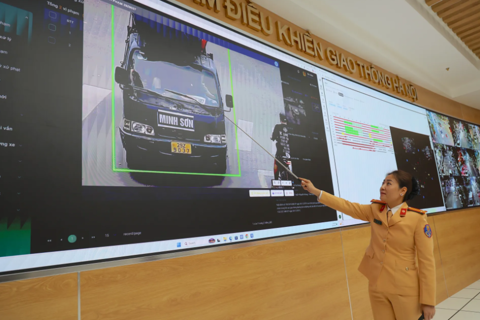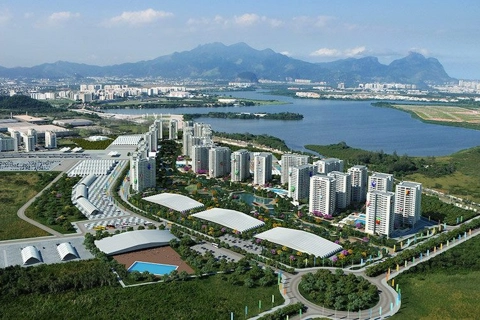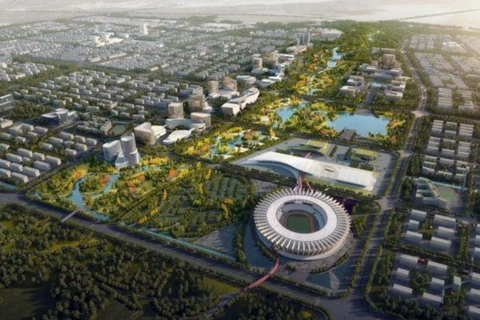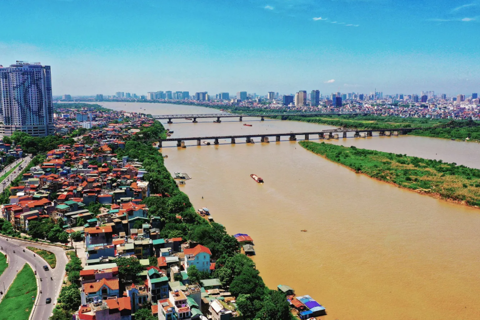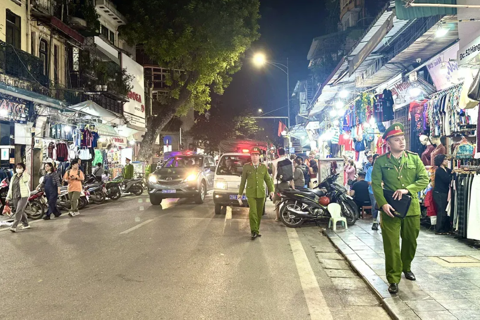Hanoi accelerates three major bridge projects in 2025
The investment decision for the three bridges, with a combined estimated cost of over US$2 billion, is scheduled to be finalized in the first quarter of 2025.
The Hanoi People's Committee has approved the investment preparation plan for three bridge projects: Tu Lien, Ngoc Hoi, and Tran Hung Dao, whose execution is scheduled to start in 2025 through public investment.
| The design of the Tu Lien Bridge. |
Speaking to The Hanoi Times, Head of Planning and Finance of the Hanoi Department of Transport Phan Truong Thanh said that the Chairman of the Hanoi People's Committee has approved the plan to accelerate the implementation of three critical bridge projects over the Red River: Tu Lien, Ngoc Hoi, and Tran Hung Dao.
He added that these bridges are intended to alleviate congestion on Thang Long and Thanh Tri bridges, enhance connectivity between the two banks of the Red River, and lay the foundation for the development of areas from the northern to the southern parts of the capital.
According to the planning, Ngoc Hoi Bridge is planned to be an inter-provincial bridge, linking Hanoi with Hung Yen Province and completing the southern section of Ring Road 3.5. Tu Lien Bridge connects the left and right banks of the river, facilitating the development of the northern areas of Hanoi, as outlined in the new urban development plans. Tu Lien Bridge is on the road that will directly connect to the Hanoi - Thai Nguyen Expressway and reach the northern Ring Road No.3, making it an intra-city and inter-provincial bridge.
Tran Hung Dao Bridge, meanwhile, is a special link between the historical downtown area (Hoan Kiem District) and Long Bien District.
“Its role is particularly significant given the growing traffic in the city,” said Thanh.
The Hanoi authorities have long identified these three bridges as priority projects for the city’s development. Initially, the Ngoc Hoi Bridge was planned to be built with public investment, while the Tu Lien and Tran Hung Dao bridges were proposed to be financed through a public-private partnership (PPP). However, the funding for both Tu Lien and Tran Hung Dao bridges has since been shifted to public investment.
"Particularly for Tu Lien Bridge, the Prime Minister has emphasized its importance to Hanoi and urged its expeditious construction to support the development of the urban area north of the Red River. Recently, the Chairman of the Hanoi People's Committee has reviewed initial reports on these three bridges," said Phan Truong Thanh.
Regarding investment preparation, the Department of Transport has received approval from the city’s leader to transfer all three bridges to public investment. The total investment is approximately VND26 trillion ($1.02 billion) for the Tu Lien Bridge (11.5 km), VND14.5 trillion ($570.4 million) for the Tran Hung Dao Bridge (6.5 km), and VND11.5 trillion ($452 million) for the Ngoc Hoi Bridge (7.5 km), part of which lies in Hung Yen Province.
The funding for the Tu Lien and Tran Hung Dao bridges will come entirely from Hanoi's budget, while the Ngoc Hoi Bridge will be built with funds from Hanoi, the central government, and Hung Yen Province. The investment proposals for these bridges have been submitted, and the Chairman of the Hanoi People's Committee has endorsed the change in investment method while urging speedy progress.
"The chairman has ordered the Department of Planning and Investment to appraise and present the investment proposals by January 2025 and submit them to the Hanoi People's Council for approval, laying the groundwork for further steps," said Thanh.
High priority
He noted that the process from investment approval to project appraisal, design, and construction remains lengthy. However, from January 1, 2025, under the revised Capital Law, these three projects will fall under the authority of the Hanoi People's Council.
Thanh expected investment decisions for the three bridges to be approved in the first quarter of 2025. Plans and contractors will be finalized in the second quarter, and construction will commence in the third quarter of 2025. Priority will be given to the Tu Lien and Ngoc Hoi bridges, while the Tran Hung Dao Bridge may be slightly delayed.
Ngoc Hoi Bridge, part of Ring Road 3.5, plays a key role in the north-south connection, as many sections of this route have already been completed. Recent progress on Thuong Cat Bridge’s investment preparation underlines the importance of advancing the Ngoc Hoi Bridge in parallel to complete the entire Ring Road 3.5 and strengthen connections with Hung Yen Province.
Hung Yen is ready to work with Hanoi on this inter-regional project. Local leaders from Hanoi and Hung Yen have reached an agreement and reported to the Prime Minister, proposing that Hanoi lead the investment. To expedite progress, land clearance will be separated as an independent project that runs parallel with the bridge construction.
Tu Lien Bridge, with its dual role as an intra-city and inter-provincial link, is vital for the rapidly developing northern urban areas. Meanwhile, Tran Hung Dao Bridge requires more thorough research, particularly regarding land clearance in the historic downtown area.
Thanh said that such large-scale projects cannot be completed in just one year. "For example, the second phase of the Vinh Tuy Bridge, which is in a similar location but requires no land clearance, still took several years. I estimate that even with rapid progress, each of these large-scale bridges would take 24 to 36 months to build and commission," he said.
Regarding investment preparation, the Department of Transport has received approval from the city’s leader to transfer all three bridges to public investment. The total investment is approximately VND26 trillion ($1.02 billion) for the Tu Lien Bridge (11.5 km), VND14.5 trillion ($570.4 million) for the Tran Hung Dao Bridge (6.5 km), and VND11.5 trillion ($452 million) for the Ngoc Hoi Bridge (7.5 km), part of which lies in Hung Yen Province. The funding for the Tu Lien and Tran Hung Dao bridges will come entirely from Hanoi's budget, while the Ngoc Hoi Bridge will be built with funds from Hanoi, the central government, and Hung Yen Province. The investment proposals for these bridges have been submitted, and the Chairman of the Hanoi People's Committee has endorsed the change in investment method while urging speedy progress. The chairman has ordered the Department of Planning and Investment to appraise and present the investment proposals by January 2025 and submit them to the Hanoi People's Council for approval, laying the groundwork for further steps. |





